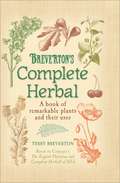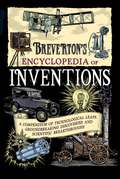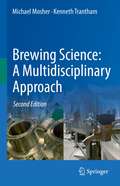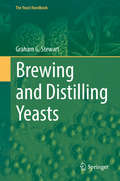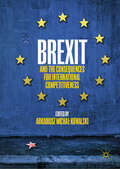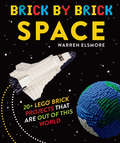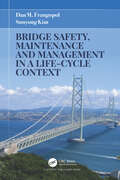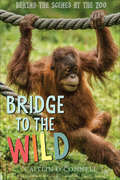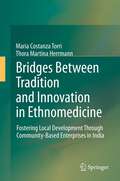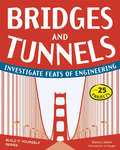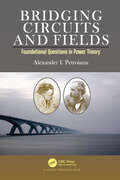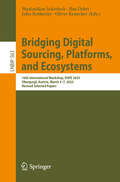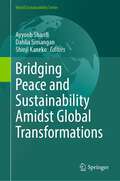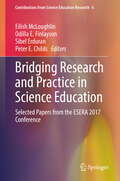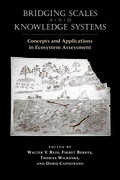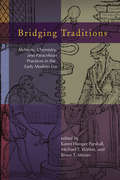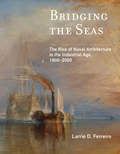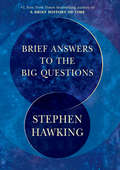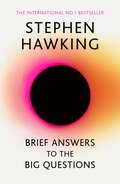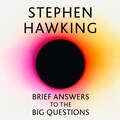- Table View
- List View
Breverton's Complete Herbal
by Terry BrevertonBreverton's Complete Herbal is a modern reworking of Culpeper's classic reference guide, Culpeper's Complete Herbal. Arranged alphabetically, this book describes over 250 herbs and spices as well as feature entries on scented herb/medicinal gardens, the great herbalists and New World Herbs not included in Culpepper's original text. Each entry provides a description of the herb: its appearance and botanical features, a brief history of its uses in medicine, dyeing and cuisine to bizarre remedies and concoctions designed to get rid of all manner of real and imaginary ailments. As informative as it is entertaining, this incredibly diverse compendium contains just about everything you'll ever need to know about the properties and provenance of herbs and spices of the world. From amara dulcis to yarrow, all-heal to viper's bugloss, Breverton's Complete Herbal is a modern day treasury of over 250 herbs and their uses.
Breverton's Encyclopedia of Inventions
by Terry BrevertonInvention and innovation are what distinguish the human race from all of the other species on Earth. Throughout history the imagination and pioneering spirit of human kind has compelled us to question why we do things in a certain way and, more importantly, how we can do things better. Celebrating the ingenuity, creativity and resourcefulness that has led to some of the most amazing technological leaps through the ages, Breverton's Encyclopedia of Inventions examines the key innovations and breakthroughs of all time and the genius behind them.Starting with the building of the pyramids in ancient Egypt and the discovery of the solar system, moving through surgery, dynamite and rockets, to modern technology such as the smart card and genetic engineering, Terry Breverton springs many surprises. He uncovers fascinating and little-known facts: for example, that Price, not Fleming, discovered penicillin; that Swan, not Edison invented the electric light, and that Wallace, not Darwin first advanced the theory of evolution. Tracing the sheer persistence of brilliant men and women across the globe, who fought the prevailing ideas of their times and advanced technology, Breverton's Encyclopedia of Inventions will inspire anyone interested in the history and developments that have changed our lives and shaped our planet's future.
Brewing Science: A Multidisciplinary Approach
by Michael Mosher Kenneth TranthamThis updated text collects all the introductory aspects of beer brewing science into one place for undergraduate brewing science courses. This expansive and detailed work is written in conversational style, walking students through all the brewing basics from the origin and history of beer to the brewing process to post-brew packaging and quality control and assurance. As an introductory text, this book assumes the reader has no prior knowledge of brewing science and only limited experience with chemistry, biology and physics. The text provides students with all the necessary details of brewing science using a multidisciplinary approach, with a thorough and well-defined program of in-chapter and end-of-chapter problems. As students solve these problems, they will learn how scientists think about beer and brewing and develop a critical thinking approach to addressing concerns in brewing science. As a truly comprehensive introduction to brewing science, Brewing Science: A Multidisciplinary Approach, Second Edition walks students through the entire spectrum of the brewing process. The different styles of beer, the molecular makeup and physical parameters, and how those are modified to provide different flavors are listed. All aspects of the brewery process, from the different setup styles to sterility to the presentation of the final product, are outlined in full. All the important brewing steps and techniques are covered in meticulous detail, including malting, mashing, boiling, fermenting and conditioning. Bringing the brewing process full circle, this text covers packaging aspects for the final product as well, focusing on everything from packaging technology to quality control. Students are also pointed to the future, with coverage of emerging flavor profiles, styles and brewing methods. Each chapter in this textbook includes a sample of related laboratory exercises designed to develop a student’s capability to critically think about brewing science. These exercises assume that the student has limited or no previous experience in the laboratory. The tasks outlined explore key topics in each chapter based on typical analyses that may be performed in the brewery. Such exposure to the laboratory portion of a course of study will significantly aid those students interested in a career in brewing science.
Brewing and Distilling Yeasts (The Yeast Handbook)
by Graham G. StewartThis book is an overview considering yeast and fermentation. The similarities and differences between yeasts employed in brewing and distilling are reviewed. The implications of the differences during the production of beer and distilled products (potable and industrial) are discussed. This Handbook includes a review of relevant historical developments and achievements in this field, the basic yeast taxonomy and biology, as well as fundamental and practical aspects of yeast cropping (flocculation), handling, storage and propagation. Yeast stress, vitality and viability are also addressed together with flavor production, genetic manipulation, bioethanol formation and ethanol production by non-Saccharomyces yeasts and a Gram-negative bacterium. This information, and a detailed account of yeast research and its implications to both the brewing and distilling processes, is a useful resource to those engaged in fermentation, yeast and their many products and processes.
Brexit and the Consequences for International Competitiveness
by Arkadiusz Michał KowalskiThis book provides a study on the impact of Brexit on international competitiveness and in doing so, presents a theoretical account of regional disintegration. In recent decades, the theory of regional economic integration has expanded following growing integration processes taking place not only in Europe, but in other continents too. The result of the EU Referendum in the United Kingdom on 23 June 2016 revealed that regional integration does not have to be a one-way process as was perceived for many years. Despite well-developed models of economic integration within economic theory, there still lacks an analytical explanation of the mechanics of disintegration. For many years, integration was commonly perceived as a beneficial process, and while disintegration is not desirable, this led to normative bias in the research on regional integration. This book, therefore, makes an important contribution to theoretical and empirical developments of regional economic disintegration.
Brick by Brick Space: 20+ LEGO Brick Projects That Are Out of This World
by Warren ElsmoreFrom a master LEGO builder comes twenty easy-to-build space projects using nothing but LEGO bricks!What's better than space or building with LEGO bricks? Building amazing space projects out of your LEGO bricks, of course! Brick by Brick Space provides more than twenty-five amazing projects to build with your LEGO bricks. Follow the easy step-by-step instructions to create space stations, satellites, planets, rocket ships, and more. Scattered throughout are fun and fascinating facts about space exploration and the various objects that are orbiting our world. This is a must-have book for any space enthusiast or LEGO lover.
Bridge Safety, Maintenance and Management in a Life-Cycle Context
by Dan M. Frangopol Sunyong KimDuring the past two decades, it has been generally acknowledged that life-cycle bridge analysis can be a systematic tool to address efficient and effective bridge management under uncertainty life-cycle management at the bridge network level can lead to an improvement in the allocation of limited financial resources, ensuring the safety and functionality of the bridge network life-cycle management of bridges and bridge networks based on resilience and sustainability can improve their resistance and robustness to extreme events such as earthquakes, tsunamis, floods, and hurricanes bridge management should consider the impact of environmental conditions and climate change This book addresses important concepts and approaches developed recently on bridge safety, maintenance, and management in a life-cycle context. Bridge life-cycle performance and cost analysis, prediction, optimization, and decision making under uncertainty are discussed. The major topics include bridge safety and service life prediction; bridge inspection and structural health monitoring; bridge maintenance; life-cycle bridge and bridge network management; optimum life-cycle bridge management planning; resilience and sustainability of bridges and bridge networksunder hazards; and bridge management considering climate change. By providing practical applications of the presented concepts and approaches, this book can help students, researchers, practitioners, infrastructure owners and managers, and transportation officials to build up their knowledge of life-cycle bridge performance and cost management at bothproject level and network level under various deteriorating mechanisms, hazards and climate change effects.
Bridge to Freedom
by Isabel R. MarvinSynopsis: It is March 1945, the last days of World War II, just inside the German front. Kurt, a German army deserter, and Rachel, a 15-year-old Jew who has escaped from the terrors of Nazi Berlin, meet. The two must trust each other in order to survive and escape. For ages 10 and up.
Bridge to the Wild: Behind the Scenes at the Zoo
by Caitlin O'ConnellHear crisp sounds of the hornbill in the cool air. Listen to the morning symphony that greets you as you enter the front gate. Then, step onto a leafy path that leads to a secret world of animals, each of whom you won&’t want to forget, here at Zoo Atlanta. Over five days we meet a menagerie of magnificent animals—pandas, elephants, gorillas, meerkats, flamingos and more—alongside the longtime animal lover, scientist, and researcher Caitlin O&’Connell. With inside access to the guidance and knowledge of their beloved zoo caretakers and with stunning photographs, we are able to see the day-to-day marvels—and sometimes misfortunes—behind the animals&’ enclosures that often go unseen by the everyday zoo visitor. In this example of narrative nonfiction at its best, O&’Connell has created a bridge to wild, a rare chance to look beyond the zoo and to inspire guests to see for themselves just how special the animals we share our world with are.
Bridges
by Lori O'Dea Lesli FavorSingle title not for individual sale. Included in larger packages only
Bridges Between Tradition and Innovation in Ethnomedicine: Fostering Local Development Through Community-Based Enterprises in India
by Thora Martina Herrmann Maria Costanza TorriCommunity-based enterprises are the result of a process in which the community acts entrepreneurially to create and operate a new enterprise embedded in its existing social structure and network. This book argues that community-based enterprise could represent a strategy for fostering sustainable local development while at the same time maintaining traditional knowledge in ethnomedicine and conserving the local ecosystems.
Bridges and Tunnels
by Donna Latham Jenn VaughnBridges and tunnels are lifelines. People have tackled seemingly insurmountable obstacles, including vast canyons and mountain ranges, to design and construct these amazing passageways. Bridges and Tunnels: Investigate Feats of Engineering invites children ages 9 and up to explore the innovation and physical science behind structures our world depends on. Trivia and fun facts illustrate engineering ingenuity and achievements. Activities and projects encourage children to learn about the engineering process and to embrace trial and error.
Bridging Circuits and Fields: Foundational Questions in Power Theory
by Alexander I. PetroianuEnergy and power are fundamental concepts in electromagnetism and circuit theory, as well as in optics, signal processing, power engineering, electrical machines, and power electronics. However, in crossing the disciplinary borders, we encounter understanding difficulties due to (1) the many possible mathematical representations of the same physical objects, and (2) the many possible physical interpretations of the same mathematical entities. The monograph proposes a quantum and a relativistic approach to electromagnetic power theory that is based on recent advances in physics and mathematics. The book takes a fresh look at old debates related to the significance of the Poynting theorem and the interpretation of reactive power. Reformulated in the mathematical language of geometric algebra, the new expression of electromagnetic power reflects the laws of conservation of energy-momentum in fields and circuits. The monograph offers a mathematically consistent and a physically coherent interpretation of the power concept and of the mechanism of power transmission at the subatomic (mesoscopic) level. The monograph proves (paraphrasing Heaviside) that there is no finality in the development of a vibrant discipline: power theory.
Bridging Digital Sourcing, Platforms, and Ecosystems: 16th International Workshop, DSPE 2025, Obergurgl, Austria, March 4–7, 2025, Revised Selected Papers (Lecture Notes in Business Information Processing #563)
by Julia Kotlarsky Ilan Oshri Oliver Krancher Maximilian SchreieckThis book constitutes revised selected papers from the 15th International Global Sourcing Workshop 2025, held in Obergurgl, Austria, in March 2025. Following an introductory chapter by the volume editors, the 9 full papers included in this book were carefully reviewed and selected from 20 submissions. The book offers a review of the key topics that bridge the sourcing, digital platforms and ecosystems literatures, populated with practical frameworks that serve as a tool kit to managers and students. The range of topics covered in this book is wide and diverse, offering various perspectives on digital platforms, ecosystems and sourcing from both behavioural and design perspectives. More specifically the book sheds light on how sourcing decisions and digital platforms interact, their relevance for innovation and the governance of digital technologies in ecosystem settings. This book is a must read for any researcher and manager whose interest is in advancing knowledge sourcing, platforms and ecosystems.
Bridging Peace and Sustainability Amidst Global Transformations (World Sustainability Series)
by Shinji Kaneko Ayyoob Sharifi Dahlia SimanganThis book is the sequel to a well-received book titled ‘Integrated Approaches to Peace and Sustainability’ that aims to further advance the understanding of the dynamic interactions between various components of peace and sustainability. How are peace and sustainability linked to each other, and what are the key parameters that define the nexus between them? This book addresses those questions through a combination of theoretical studies and empirical research that contextualize peace and sustainability issues amid global transformations. The conceptual and empirical linkages between peace and sustainability are widely recognized in academic and policy circles. The adoption of the 2030 Agenda for Sustainable Development confirms this recognition. However, many of the initiatives on peace and sustainability operate in silos, undermining the positive and mutually reinforcing relationship between them. Enhanced integration of peace and sustainability components is imperative for addressing complex challenges that come with global transformations that are manifested environmentally, socially, politically, and economically across levels. It is, therefore, crucial to identify the pathways that enhance the peace-promoting potential of sustainability and the sustainability-promoting potential of peace. The contributions in this edited book elaborate on such pathways by offering insights related to different social, economic, and environmental aspects of the peace-sustainability nexus. Given its inter- and trans-disciplinary focus, the book is of interest to policymakers and researchers working in different areas of peace and sustainability. It contributes to ongoing academic and policy discussions surrounding the outcomes of and challenges to achieving the Sustainable Development Goals (SDGs), particularly SDG 16 on peace, justice and strong institutions.
Bridging Research and Practice in Science Education: Selected Papers from the ESERA 2017 Conference (Contributions from Science Education Research #6)
by Sibel Erduran Eilish McLoughlin Odilla E. Finlayson Peter E. ChildsThis edited volume presents innovative current research in the field of Science Education. The chapter’s deal with a wide variety of topics and research approaches, conducted in a range of contexts and settings. Together they make a strong contribution to knowledge on science teaching and learning. The book consists of selected presentations from the 12th European Science Education Research Association (ESERA) Conference, held in Dublin, Ireland from 21st to 25th August, 2017. The ESERA community is made up of professionals with diverse disciplinary backgrounds from natural sciences to social sciences. This diversity enables a rich understanding of cognitive and affective aspects of science teaching and learning. The studies in this book will stimulate discussion and interest in finding new ways of implementing and researching science education for the future. The twenty-two chapters in this book are presented in four parts highlighting innovative approaches to school science, emerging identities in science education, approaches to developing learning and competence progressions, and ways of enhancing science teacher education. This collection of studies showcases current research orientations in science education and is of interest to science teachers, teacher educators and science education researchers around the world with a commitment to bridging research and practice in science teaching and learning.
Bridging Scales and Knowledge Systems: Concepts and Applications in Ecosystem Assessment
by Fikret Berkes Walter Reid Doris Capistrano Walter Millennium Ecosystem Assessment Walter World Resources Institute Thomas WilbanksBridging the gap between local knowledge and western science is essential to understanding the world's ecosystems and the ways in which humans interact with and shape those ecosystems. This book brings together a group of world-class scientists in an unprecedented effort to build a formal framework for linking local and indigenous knowledge with the global scientific enterprise. Contributors explore the challenges, costs, and benefits of bridging scales and knowledge systems in assessment processes and in resource management. Case studies look at a variety of efforts to bridge scales, providing important lessons concerning what has worked, what has not, and the costs and benefits associated with those efforts. Drawing on the groundbreaking work of the Millennium Eco-system Assessment, Bridging Scales and Knowledge Systems will be indispensable for future efforts to conduct ecosystem assessments around the world.
Bridging Traditions: Alchemy, Chemistry, and Paracelsian Practices in the Early Modern Era (Early Modern Studies #15)
by Michael Walton Karen Parshall Bruce MoranBridging Traditions explores the connections between apparently different zones of comprehension and experience—magic and experiment, alchemy and mechanics, practical mathematics and geometrical mysticism, things earthy and heavenly, and especially science and medicine—by focusing on points of intersection among alchemy, chemistry, and Paracelsian medical philosophy. In exploring the varieties of natural knowledge in the early modern era, the authors pay tribute to the work of Allen Debus, whose own endeavors cleared the way for scholars to examine subjects that were once snubbed as suitable only to the refuse heap of the history of science.
Bridging Traditions: Alchemy, Chemistry, and Paracelsian Practices in the Early Modern Era (Early Modern Studies)
by Michael Walton Karen Parshall Bruce MoranBridging Traditions explores the connections between apparently different zones of comprehension and experience—magic and experiment, alchemy and mechanics, practical mathematics and geometrical mysticism, things earthy and heavenly, and especially science and medicine—by focusing on points of intersection among alchemy, chemistry, and Paracelsian medical philosophy. In exploring the varieties of natural knowledge in the early modern era, the authors pay tribute to the work of Allen Debus, whose own endeavors cleared the way for scholars to examine subjects that were once snubbed as suitable only to the refuse heap of the history of science.
Bridging the Gap Between Aristotle’s Science and Ethics
by Henry, Devin and Nielsen, Karen Margrethe Devin Henry Karen Margrethe NielsenThis book consolidates emerging research on Aristotle's science and ethics in order to explore the extent to which the concepts, methods, and practices he developed for scientific inquiry and explanation are used to investigate moral phenomena. Each chapter shows, in a different way, that Aristotle's ethics is much more like a science than it is typically represented. The upshot of this is twofold. First, uncovering the links between Aristotle's science and ethics promises to open up new and innovative directions for research into his moral philosophy. Second, showing why Aristotle thinks ethics can never be fully assimilated to the model of science will help shed new light on his views about the limits of science. The volume thus promises to make a significant contribution to our understanding of the epistemological, metaphysical, and psychological foundations of Aristotle's ethics.
Bridging the Gap between Life and Physics
by Ron Cottam Willy RansonThis is the only book which deals with the correlatory comparison between hierarchical living systems and inorganic physical ones. The culmination of the book is the proposition of research to discover and understand the natural underlying level of organization which produces the descriptive commonality of life and physics. Traditional science eliminates life from its purview by its rejection of interrelationships as a primary content of systems. The conventional procedure of science is that of reductionism, whereby complex systems are dismantled to characterize lower level components, but virtually no attention is given to how to rebuild those systems—the underlying assumption is that analysis and synthesis are symmetrical. This book fulfills two main coupled functions. Firstly, it details hierarchy as the major formulation of natural complex systems and investigates the fundamental character of natural hierarchy as a widely transferable ‘container’ of structure and/or function – and this in the case of the new development of a representational or model hierarchy. Secondly, it couples this hierarchical description to that of the electronic properties of semiconductors, as a well-modeled canonical example of physical properties. The central thesis is that these two descriptions are comparable, if care is taken to treat logical and epistemological aspects with prudence: a large part of the book is composed of just this aspect of care for grounding consistency. As such great attention is given to correct assessment of argumentative features which are otherwise presumed ‘known’ but which are usually left uncertain. Development of the ideas is always based on a relationship between entity or phenomenon and their associated ecosystems, and this applies equally well to the consequent derivations of consciousness and information.
Bridging the Seas: The Rise of Naval Architecture in the Industrial Age, 1800-2000 (Transformations: Studies in the History of Science and Technology)
by Larrie D. FerreiroHow the introduction of steam, iron, and steel required new rules and new ways of thinking for the design and building of ships.In the 1800s, shipbuilding moved from sail and wood to steam, iron, and steel. The competitive pressure to achieve more predictable ocean transportation drove the industrialization of shipbuilding, as shipowners demanded ships that enabled tighter scheduling, improved performance, and safe delivery of cargoes. In Bridging the Seas, naval historian Larrie Ferreiro describes this transformation of shipbuilding, portraying the rise of a professionalized naval architecture as an integral part of the Industrial Age. Picking up where his earlier book, Ships and Science, left off, Ferreiro explains that the introduction of steam, iron, and steel required new rules and new ways of thinking for designing and building ships. The characteristics of performance had to be first measured, then theorized. Ship theory led to the development of quantifiable standards that would ensure the safety and quality required by industry and governments, and this in turn led to the professionalization of naval architecture as an engineering discipline. Ferreiro describes, among other things, the technologies that allowed greater predictability in ship performance; theoretical developments in naval architecture regarding motion, speed and power, propellers, maneuvering, and structural design; the integration of theory into ship design and construction; and the emergence of a laboratory infrastructure for research.
Brief Answers to the Big Questions
by Stephen HawkingThe world-famous cosmologist and #1 bestselling author of A Brief History of Time leaves us with his final thoughts on the biggest questions facing humankind. <P><P>Stephen Hawking was the most renowned scientist since Einstein, known both for his groundbreaking work in physics and cosmology and for his mischievous sense of humor. He educated millions of readers about the origins of the universe and the nature of black holes, and inspired millions more by defying a terrifying early prognosis of ALS, which originally gave him only two years to live. In later life he could communicate only by using a few facial muscles, but he continued to advance his field and serve as a revered voice on social and humanitarian issues. <P><P>Hawking not only unraveled some of the universe’s greatest mysteries but also believed science plays a critical role in fixing problems here on Earth. Now, as we face immense challenges on our planet—including climate change, the threat of nuclear war, and the development of artificial intelligence—he turns his attention to the most urgent issues facing us. Will humanity survive? Should we colonize space? Does God exist? <P><P>These are just a few of the questions Hawking addresses in this wide-ranging, passionately argued final book from one of the greatest minds in history. Featuring a foreword by Eddie Redmayne, who won an Oscar playing Stephen Hawking, an introduction by Nobel Laureate Kip Thorne, and an afterword from Hawking’s daughter, Lucy, Brief Answers to the Big Questions is a brilliant last message to the world. <P><b>A New York Times Bestseller</b>
Brief Answers to the Big Questions: 'A beautiful little book by a brilliant mind' DAILY TELEGRAPH
by Stephen HawkingTHE NO.1 SUNDAY TIMES BESTSELLER'A beautiful little book by a brilliant mind' DAILY TELEGRAPH'Effortlessly instructive, absorbing, up to the minute and - where it matters - witty' GUARDIANThe world-famous cosmologist and #1 bestselling author of A Brief History of Time leaves us with his final thoughts on the universe's biggest questions in this brilliant posthumous work.Is there a God?How did it all begin?Can we predict the future?What is inside a black hole?Is there other intelligent life in the universe?Will artificial intelligence outsmart us?How do we shape the future?Will we survive on Earth?Should we colonise space?Is time travel possible?Throughout his extraordinary career, Stephen Hawking expanded our understanding of the universe and unravelled some of its greatest mysteries. But even as his theoretical work on black holes, imaginary time and multiple histories took his mind to the furthest reaches of space, Hawking always believed that science could also be used to fix the problems on our planet.And now, as we face potentially catastrophic changes here on Earth - from climate change to dwindling natural resources to the threat of artificial super-intelligence - Stephen Hawking turns his attention to the most urgent issues for humankind.Wide-ranging, intellectually stimulating, passionately argued, and infused with his characteristic humour, Brief Answers to the Big Questions, the final book from one of the greatest minds in history, is a personal view on the challenges we face as a human race, and where we, as a planet, are heading next.A percentage of all royalties will go to charity.
Brief Answers to the Big Questions: the final book from Stephen Hawking
by Stephen HawkingRead by Ben Whishaw and Garrick Hagon, with an afterword read by Lucy Hawking. The world-famous cosmologist and #1 bestselling author of A Brief History of Time leaves us with his final thoughts on the universe's biggest questions in this brilliant posthumous work.How did the universe begin? Will humanity survive on Earth? Is there intelligent life beyond our solar system? Could artificial intelligence ever outsmart us?Throughout his extraordinary career, Stephen Hawking expanded our understanding of the universe and unravelled some of its greatest mysteries. But even as his theoretical work on black holes, imaginary time and multiple histories took his mind to the furthest reaches of space, Hawking always believed that science could also be used to fix the problems on our planet.And now, as we face potentially catastrophic changes here on Earth - from climate change to dwindling natural resources to the threat of artificial super-intelligence - Stephen Hawking turns his attention to the most urgent issues for humankind.Wide-ranging, intellectually stimulating, passionately argued, and infused with his characteristic humour, BRIEF ANSWERS TO THE BIG QUESTIONS, the final book from one of the greatest minds in history, is a personal view on the challenges we face as a human race, and where we, as a planet, are heading next.A percentage of all royalties will go to charity.(P)2018 Hodder & Stoughton Limited
